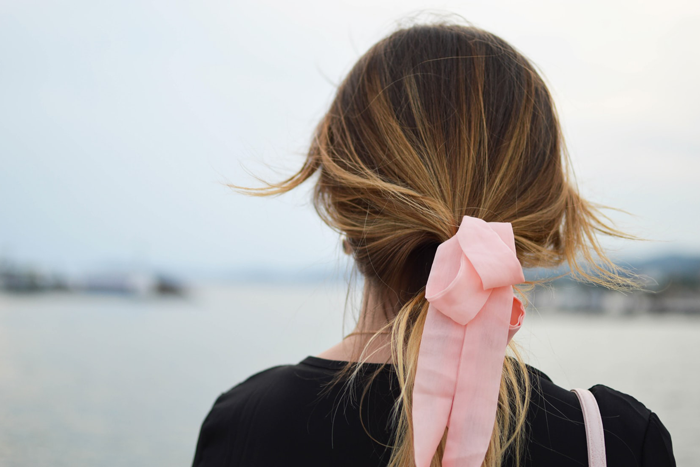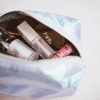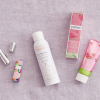 Feature Image by Tamara Bellis
Feature Image by Tamara Bellis
From hormonal imbalance to nutritional deficits and genetics, several health and lifestyle factors can impact hair loss and thinning to the point where a person may even suffer severe conditions such as finasteride. Shedding that goes beyond 100-125 strands per day could be due to something as specific as thyroid imbalance or a change to your birth control pills.
According to cosmetic dermatologist Ava Shamban MD, the natural hair aging process (yep, that’s a thing) may be the true culprit. Parallel to skin aging (where the production of collagen and elastin drops in the mid-20s), our hair follicles, the part of the scalp where hair fiber is created, decreases production and can even shrink between the ages of 20-25.
“[Even if symptoms] are not necessarily visible yet,” begins Shamban, “the loss of color, changes in texture, brittleness, and loss of volume are all associated with aging hair.” Impacting the texture, density, and thickness of our strands, the bottom line is: “The healthier the scalp and follicles, [the healthier] your hair will look and feel.”
Here is everything you should know about hair loss — including what to do — according to experts.
Take vitamins
“Hair cells are the last to get nutrition,” explains Lamees Hamdan MD, founder and CEO of Shiffa Beauty, “That’s why, for healthy hair, you really want to make sure your intake of vitamins and minerals are on the higher side of normal.” Some good vitamins to look for include niacin and biotin, while amla, saw palmetto extract, and ketoconazole are all reported to help curb DHT, which Shamban explains controls the hormone associated with hair loss and baldness. Naturopathic doctor Nadia Musavvir ND lists vitamin D, ferritin, zinc, protein, and essential fatty acids as being common nutritional deficits found in those suffering hair loss. We recommend the DL.MD Liquid Multi-Vitamin Supplement, which is a liquid multi-vitamin with vitamin C, vitamin E, and biotin.
Brush your hair
Brushing your hair stimulates the follicles, improves circulation, and distributes the scalp’s protective oils between strands. As trichologist and stylist Bridgette Hill with Paul Labrecque Salon and Skincare Spa explains, proper scalp circulation helps to ensure that “blood flows easily to the roots of the hair bulb, and increases nutrients to the follicle.” Overall, this supports the healthy growth of the hair fiber and minimizes thinning. Our favorite brush is the Briogeo Vegan Boar Bristle Hair Brush that gently detangles all hair types and massages the scalp with multi-layered bristles.
Use high-quality ingredients
Shamban points out the importance of using high-quality, solution-focused active ingredients on your hair and scalp, just as we do with our skin care. “What you don’t want to do is mask damage and problems with products that give the appearance of looking healthier [but that] are made with chemicals that will worsen the condition overall,” she says. “Choosing hair products and ingredients as carefully as we choose for our faces is key.” Better topical ingredients translate into immediate improvement in superficial vibrance, shine, and density, as well as longer-term benefits. And using high-quality ingredients all starts with your shampoo and conditioner. We recommend the SEEN Shampoo and Conditioner, which is formulated without sulfates, silicones, and other irritations to leave your scalp balanced.
Take care of your scalp
Since the scalp is the organ responsible for the hair fibers, which are created in the follicles, healthy hair begins with the scalp. Hill explains, “Hair loss has to be addressed through the blood, tissue, and cells. Scalp health [covers] the tissue and cell component of hair health.” Scalp care may include exfoliating salicylic acid or scrubs, hydrating ingredients hyaluronic acid, and nourishing oils like olive, rice bran, grapeseed, or castor seed oil. “Proper scalp care keeps the muscles of the scalp firing and keeps the connective tissues loose,” she notes. “[It] also reduces inflammation, which keeps the follicle nourished.” We love The Ordinary Multi-Peptide Serum for Hair Density or Reverie CAKE Restorative Scalp Tonic to nourish the scalp and help hair look thicker and more dense.
Consider a treatment
Topicals, light therapies, injectables, corticosteroids, and hormone therapies — or a combination of treatments — are all offered with varying degrees of success. In January 2020, celebrity-beloved HydraFacial began offering treatments for the scalp with verified results in hair texture, strand thickness, and color. The treatment consists of three non-invasive, in-office treatments with the device, and the use of a scalp serum of peptides and growth factors. Combining treatments like the Hydrafacial Keravive and injections of platelet-rich plasma (PRP) is an excellent way to improves micro-circulation and stimulate the hair follicles optimally for visible results. For at-home TLC, try a DIY scalp massaging or derma-roll your scalp with the Foligain Hair & Scalp Roller with 540 Titanium Needles.
Prevent breakage
When you’re trying to protect fragile strands from damage, be wary not to over-do it with overly harsh products or treatments like dye and bleaching. Using a silk pillowcase or turban is a great way to reduce friction and prevent split ends overnight, while hair experts shun towel-drying your hair in favor of gentler, more efficient microfiber hair towels. We like to sleep in the Slip Pure Silk Turban to protect it from the effects of friction throughout the night.
xx, The FabFitFun Team






